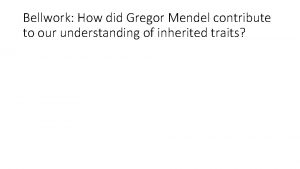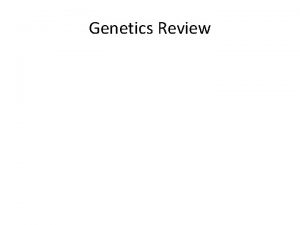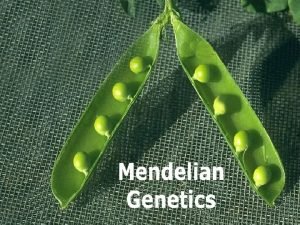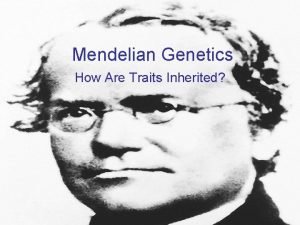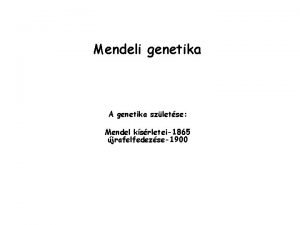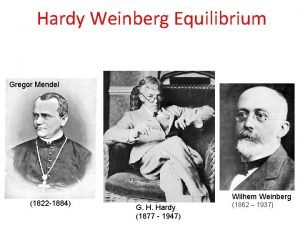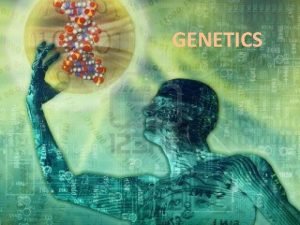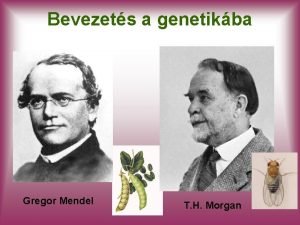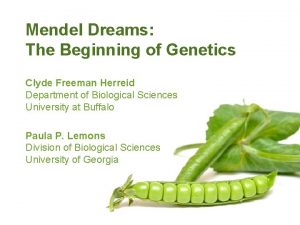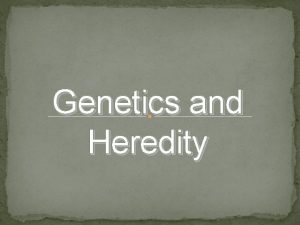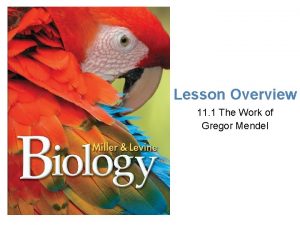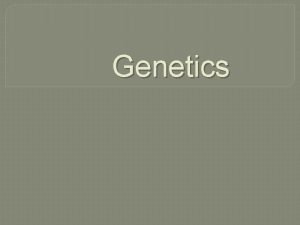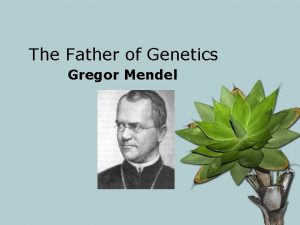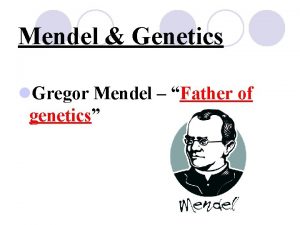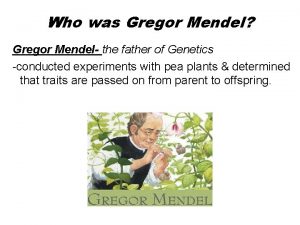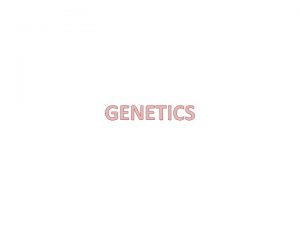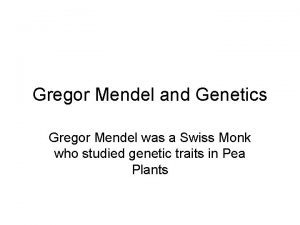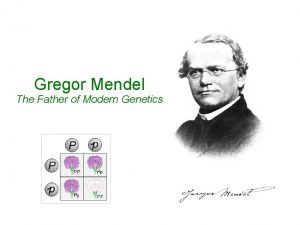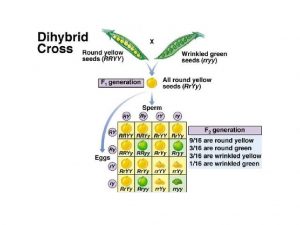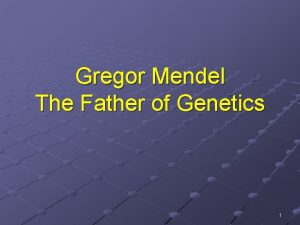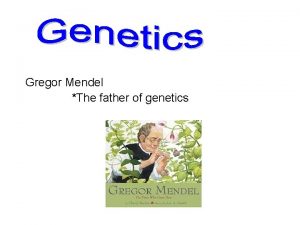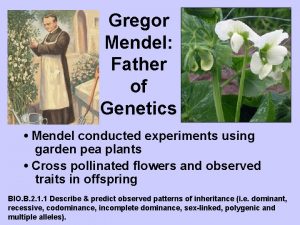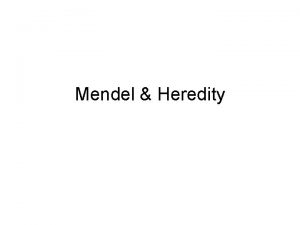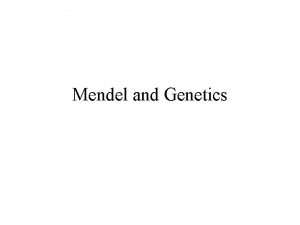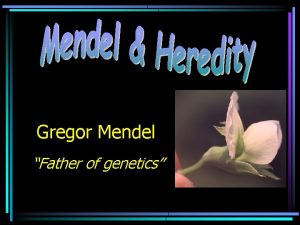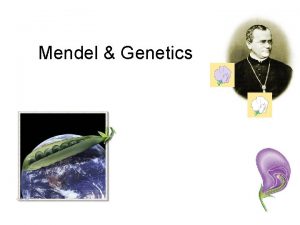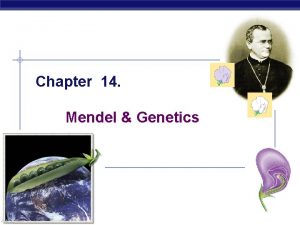Genetics Notes Who is Gregor Mendel Father of






















- Slides: 22

Genetics Notes Who is Gregor Mendel? “Father of Genetics” Principle of Independent Assortment – Inheritance of one trait has no effect on the inheritance of another trait

Traits • Genetics – study of how traits are passed from parent to offspring

• Traits are determined by the genes on the chromosomes. A gene is a segment of DNA that determines a trait.

• Chromosomes come in homologous pairs, thus genes come in pairs. Homologous pairs – matching genes – one from female parent and one from male parent • Example: Humans have 46 chromosomes or 23 pairs. One set from dad – 23 in sperm One set from mom – 23 in egg

• One pair of Homologous Chromosomes: Gene for eye color (blue eyes) Homologous pair of chromosomes Gene for eye color (brown eyes) Alleles – different genes (possibilities) for the same trait – ex: blue eyes or brown eyes

Dominant and Recessive Genes • Gene that prevents the other gene from “showing” – dominant • Gene that does NOT “show” even though it is present – recessive • Symbol – Dominant gene – upper case letter – T Recessive gene – lower case letter – t Dominant color Recessive color

Example: Straight thumb is dominant to hitchhiker thumb T = straight thumb t = hitchhikers thumb (Always use the same letter for the same alleles— No S = straight, h = hitchhiker’s) Straight thumb = TT Straight thumb = Tt Hitchhikers thumb = tt * Must have 2 recessive alleles for a recessive trait to “show”

• Both genes of a pair are the same – homozygous or purebred TT – homozygous dominant tt – homozygous recessive • One dominant and one recessive gene – heterozygous or hybrid Tt – heterozygous BB – Black Bb – Black w/ white gene bb – White

Genotype and Phenotype • Combination of genes an organism has (actual gene makeup) – genotype Ex: TT, Tt, tt • Physical appearance resulting from gene make-up – phenotype Ex: hitchhiker’s thumb or straight thumb

Punnett Square and Probability • Used to predict the possible gene makeup of offspring – Punnett Square • Example: Black fur (B) is dominant to white fur (b) in mice 1. Cross a heterozygous male with a homozygous recessive female. Black fur (B) Heterozygous male White fur (b) Homozygous recessive female White fur (b)

Male = Bb X Female = bb b Male gametes - N (One gene in sperm) B b b Bb Bb bb bb Female gametes – N (One gene in egg) Possible offspring – 2 N Write the ratios in the following orders: Genotypic ratio = 2 Bb : 2 bb 50% Bb : 50% bb Genotypic ratio homozygous : heterozygous : homozygous Phenotypic ratio = 2 black : 2 white dominant 50% black : 50% white Phenotypic ratio dominant : recessive

Cross 2 hybrid mice and give the genotypic ratio and phenotypic ratio. B b B BB Bb bb Bb X Bb Genotypic ratio = 1 BB : 2 Bb : 1 bb 25% BB : 50% Bb : 25% bb Phenotypic ratio = 3 black : 1 white 75% black : 25% white

Example: A man and woman, both with brown eyes (B) marry and have a blue eyed (b) child. What are the genotypes of the man, woman and child? Bb X Bb Man = Bb B BB Bb bb Woman = Bb

• What is the probability of a couple having a boy? Or a girl? Chance of having female baby? 50% X X X XX XX Y XY XY Who determines the sex of the child? father

Incomplete dominance and Codominance • When one allele is NOT completely dominant over another (they blend) – incomplete dominance Example: In carnations the color red (R) is incompletely dominant over white (W). The hybrid color is pink. Give the genotypic and phenotypic ratio from a cross between 2 pink flowers. RW X RW R R W RR RW WW Genotypic = 1 RR : 2 RW : 1 WW Phenotypic = 1 red : 2 pink : 1 white

• When both alleles are expressed – Codominance Example: In certain chickens black feathers are codominant with white feathers. Heterozygous chickens have black and white speckled feathers.

Sex – linked Traits • Genes for these traits are located only on the X chromosome (NOT on the Y chromosome) • X linked alleles always show up in males whether dominant or recessive because males have only one X chromosome

• Examples of recessive sex-linked disorders: 1. colorblindness – inability to distinguish between certain colors You should see 58 (upper left), 18 (upper right), E (lower left) and 17 (lower right). Color blindness is the inability to distinguish the differences between certain colors. The most common type is red-green color blindness, where red and green are seen as the same color.

2. hemophilia – blood won’t clot

Example: What would be the possible blood types of children born to a female with type AB blood and a male with type O blood? AB X OO A O AO B BO O AO BO Children would be type A or B only

Mutations • Mutation – sudden genetic change (change in base pair sequence of DNA) • Can be : Harmful mutations – organism less able to survive: genetic disorders, cancer, death Beneficial mutations – allows organism to better survive: provides genetic variation Neutral mutations – neither harmful nor helpful to organism • Mutations can occur in 2 ways: chromosomal mutation or gene/point mutation

• Examples: Down’s syndrome – (Trisomy 21) 47 chromosomes, extra chromosome at pair #21
 Gregor mendel a monk
Gregor mendel a monk How did gregor mendel contribute to genetics
How did gregor mendel contribute to genetics Gregor mendel’s principles of genetics apply to
Gregor mendel’s principles of genetics apply to What did gregor mendel do
What did gregor mendel do Gregor mendel
Gregor mendel Austrian genetic traits
Austrian genetic traits ____________is the austrian monk who experimented with
____________is the austrian monk who experimented with Gregor mendel
Gregor mendel Gregor mendel
Gregor mendel Gregor mendel munkássága
Gregor mendel munkássága Incomplete dominance
Incomplete dominance 5 conditions of hardy weinberg
5 conditions of hardy weinberg Who is gregor mendel and what did he do?
Who is gregor mendel and what did he do? Chapter 11 the work of gregor mendel
Chapter 11 the work of gregor mendel Gregor mendel conclusions
Gregor mendel conclusions Fr gregor mendel
Fr gregor mendel Rryy x rryy
Rryy x rryy Gregor mendel video
Gregor mendel video Gregor mendel summary
Gregor mendel summary Gregor johann mendel
Gregor johann mendel Gregor mendel 1865
Gregor mendel 1865 What did gregor mendel research
What did gregor mendel research Mendel
Mendel

